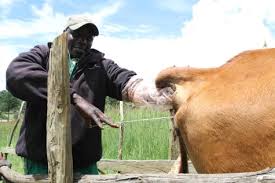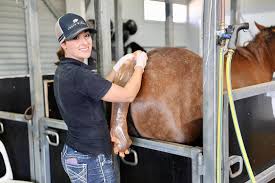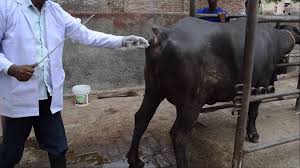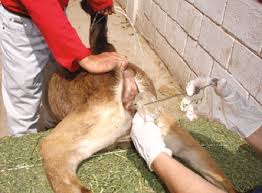Artificial Insemination (AI) is a reproductive technology widely used in animal breeding to improve genetic quality and increase production. Through this process, semen is collected from a male animal, typically one with desirable traits, and then artificially introduced into a female animal’s reproductive tract.
This method bypasses natural mating and allows breeders to enhance specific genetic traits, control breeding programs more effectively, and reduce the spread of diseases that can occur during physical contact between animals.
AI is a significant advancement in animal husbandry, particularly in dairy, beef, swine, and poultry industries, where genetic improvement is essential for economic success.
By selecting top-quality males with traits like high milk yield, meat quality, or disease resistance, breeders can optimize their herds and flocks, achieving superior offspring that meet specific production goals.
Additionally, AI allows access to elite sires from around the world, even if the animals are located in different countries, enabling farmers to incorporate diverse genetics into their breeding programs.
The process of artificial insemination includes semen collection, evaluation, preservation, and insemination. The semen is often frozen and stored, allowing breeders to use it when optimal breeding conditions are present.
This flexibility ensures higher success rates, as farmers can synchronize insemination with the females’ reproductive cycles. Moreover, AI reduces the costs associated with maintaining multiple male animals and helps control the population of livestock in a sustainable manner.
Artificial insemination in animal breeding offers a valuable solution for genetic improvement, disease control, and efficient management, making it an indispensable tool in modern agriculture.
As technology advances, AI continues to evolve, contributing to more productive, sustainable, and profitable livestock operations worldwide.
History and Development of Artificial Insemination
The concept of Artificial Insemination (AI) has ancient origins, with the first recorded attempts dating back to 14th-century Arabian horse breeding. However, it wasn’t until the late 18th century that the first documented scientific success occurred.
Italian physiologist Lazzaro Spallanzani is credited with successfully using AI on dogs in 1780, demonstrating the feasibility of the technique.
In the early 20th century, Russian scientist Ilya Ivanovich Ivanov further developed AI for various animals, including horses and cattle. By the 1930s and 1940s, advancements in semen collection, preservation, and insemination techniques enabled AI to become a practical tool for animal breeding.
During this time, liquid semen storage and the use of extenders (nutrients and antibiotics) were developed, allowing for broader application in livestock breeding.
As the technology progressed, the 1950s saw the invention of cryopreservation methods, making it possible to freeze semen, transport it globally, and store it for extended periods.
These advancements have contributed to AI becoming a cornerstone of modern animal breeding, benefiting industries like dairy, beef, poultry, and swine.
Benefits of Artificial Insemination in Animal Breeding

Artificial Insemination offers numerous advantages in animal breeding, such as:
1. Genetic Improvement: AI allows breeders to select high-quality sires with desirable traits, leading to genetically superior offspring.
2. Disease Control: AI reduces the risk of sexually transmitted diseases by minimizing direct animal contact.
3. Increased Efficiency: Farmers can synchronize breeding schedules, optimizing reproductive cycles for higher conception rates.
4. Cost-Effectiveness: AI reduces the need to keep multiple male animals on a farm, cutting down on feed and maintenance costs.
5. Global Genetic Access: Farmers can access semen from elite sires worldwide, allowing the incorporation of diverse genetics into their herds.
6. Conservation: AI aids in preserving rare and endangered species by allowing genetic material to be stored and used when needed.
Types of Artificial Insemination Techniques
1. Vaginal Insemination: Common in animals like sheep, this technique involves depositing semen in the vaginal canal. It’s a simpler, less invasive method but has a lower conception rate.
2. Cervical Insemination: Often used in pigs, where semen is placed directly in the cervix, increasing the chance of successful fertilization compared to vaginal insemination.
3. Transcervical Insemination:: technique commonly used in cattle, where semen is deposited directly into the uterus, bypassing the cervix. This method has a higher success rate than cervical and vaginal insemination.
4. Laparoscopic Insemination: Primarily used in sheep and certain other animals, this surgical technique allows semen to be deposited directly in the uterine horns. It’s more invasive but highly effective for achieving pregnancy in smaller species.
5. Intracytoplasmic Sperm Injection (ICSI): This advanced technique involves injecting a single sperm cell directly into an egg and is commonly used in veterinary medicine for species with low sperm count or fertility issues.
Read Also: Bacterial Canker (Stone fruit trees): Description, Damages Caused, Control and Preventive Measures
Step-by-Step Guide to the Artificial Insemination Process

Artificial Insemination (AI) follows a structured process to ensure the best chance of successful fertilization. Here’s a simplified step-by-step guide:
1. Semen Collection: Preparation involves getting the male animal ready for semen collection, usually through the use of a dummy mount or an artificial vagina; collection is done by trained personnel to gather the semen, which is evaluated for quality, including sperm motility and concentration.
2. Semen Evaluation and Processing: A quality check is performed to examine the semen under a microscope for high sperm quality; dilution and preservation involve mixing the semen with extenders (nutrients and antibiotics) and either chilling it for short-term use or cryopreserving (freezing) it for long-term storage.
3. Heat Detection in Females: AI should be conducted when the female animal is in estrus (heat); farmers use visual cues or detection aids like heat patches or hormonal tests to identify the optimal breeding time.
4. Insemination: Preparation includes restraining the female animal and getting the AI technician ready; the insemination procedure involves placing the semen in the reproductive tract (vaginal, cervical, or transcervical) using a catheter, insemination rod, or laparoscopic tool.
5. Post-Insemination Care: The female is monitored for any signs of discomfort and observed for pregnancy signs after about 21-28 days, depending on the animal species.
Selecting Suitable Animals for Artificial Insemination
1. Assess Health and Genetics: Both male and female animals should be in good health and free from diseases; males are selected based on desirable traits like high production levels, good physical conformation, and genetic superiority.
2. Evaluate Reproductive History: Review the female’s reproductive history to ensure she is suitable for AI, focusing on factors like past conception rates and any history of reproductive issues.
3. Identify Estrus Cycles in Females: Accurate detection of estrus cycles is essential for successful AI; this involves monitoring behavioral signs (e.g., mounting or restlessness) or using estrus detection tools.
4. Optimize Animal Nutrition: Proper nutrition before and during breeding is vital; animals should receive a balanced diet rich in vitamins and minerals to support reproductive health.
Equipment and Materials Used in Artificial Insemination
1. Artificial Vagina (AV): Used for semen collection from male animals, simulating the natural environment and making collection more comfortable for the animal.
2. Semen Extenders: Liquid solutions containing nutrients and antibiotics that preserve semen quality; they help in diluting semen for larger insemination batches.
3. Semen Straws: Sealed tubes that hold processed semen, often used for storage and later insemination.
4. Insemination Gun or Catheter: Tools used to place semen into the female’s reproductive tract; different types are used based on the animal species and insemination method.
5. Cryogenic Storage Tanks: Tanks that store semen at extremely low temperatures, preserving it for long-term use; liquid nitrogen is commonly used for freezing and storing semen.
6. Personal Protective Equipment (PPE): Includes gloves, aprons, and other items essential for maintaining hygiene and preventing contamination during the AI process.
7. Estrus Detection Aids: Tools like heat patches, pedometers, and hormone testing kits that help identify when female animals are in estrus, optimizing the timing of AI.
Read Also: 18 Medicinal Health Benefits Of Hydnocarpus wightianus (Chaulmoogra)
Factors Influencing the Success of Artificial Insemination

1. Timing of Insemination: The timing must align with the female’s estrus cycle; inseminating too early or too late can lead to lower conception rates.
2. Semen Quality: High-quality semen is crucial for successful fertilization; factors such as sperm motility, concentration, and morphology play a vital role in determining semen quality.
3. Insemination Technique: The skill and experience of the technician performing the AI are critical; proper techniques ensure accurate placement of semen in the reproductive tract.
4. Female Reproductive Health: The overall health of the female animal influences success; issues like infections, hormonal imbalances, or uterine abnormalities can hinder fertilization.
5. Environmental Conditions: Stress from environmental factors, such as extreme temperatures or poor housing conditions, can negatively affect reproductive performance.
6. Nutrition: Adequate nutrition before and after insemination is vital; a balanced diet helps maintain the health of both the male and female animals, supporting successful reproduction.
Challenges and Limitations of Artificial Insemination
While AI has many advantages, it also faces several challenges and limitations:
1. Training and Expertise: AI requires skilled personnel; insufficient training can lead to improper techniques, resulting in lower success rates.
2. Cost of Equipment and Technology: The initial investment in AI equipment, storage facilities, and training can be high, making it less accessible for some farmers.
3. Limited Genetic Diversity: Relying on a small number of high-quality sires can lead to reduced genetic diversity, which may negatively impact the overall health of livestock populations.
4. Semen Preservation Challenges: Maintaining the quality of frozen semen can be challenging; improper handling or storage conditions can lead to decreased viability.
5. Health Risks: The spread of diseases through improperly handled semen is a concern; stringent biosecurity measures are needed to mitigate risks.
6. Acceptance and Cultural Barriers: Some farmers may be resistant to adopting AI practices due to cultural beliefs or traditional breeding methods, hindering the widespread use of the technology.
Do you have any questions, suggestions, or contributions? If so, please feel free to use the comment box below to share your thoughts. We also encourage you to kindly share this information with others who might benefit from it. Since we can’t reach everyone at once, we truly appreciate your help in spreading the word. Thank you so much for your support and for sharing!
Read Also: Tips for Maintaining a Clean Garbage Disposal
Frequently Asked Questions
We will update this section soon.

